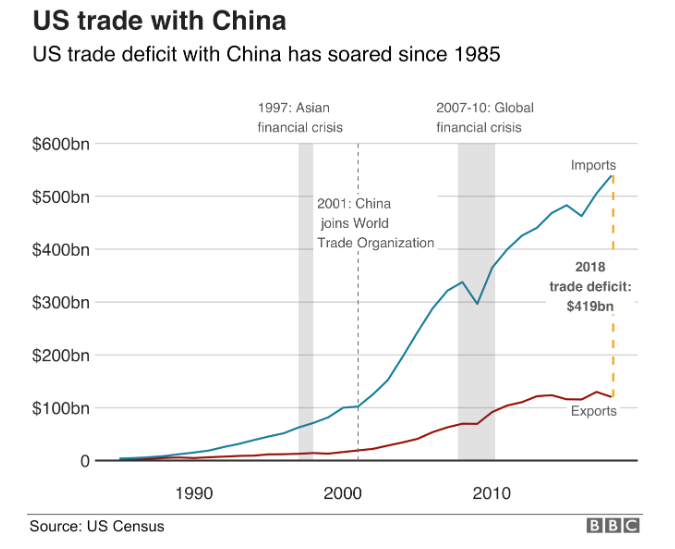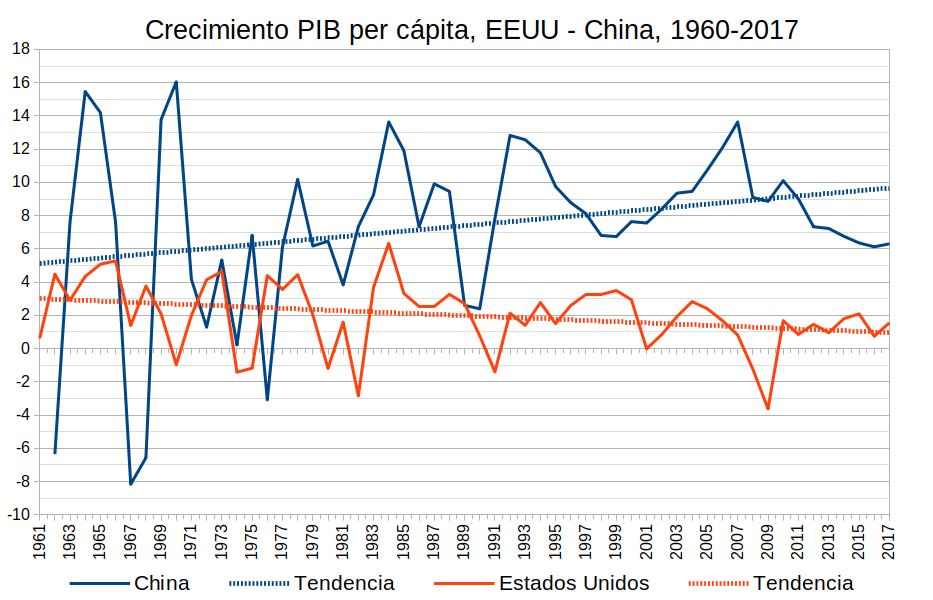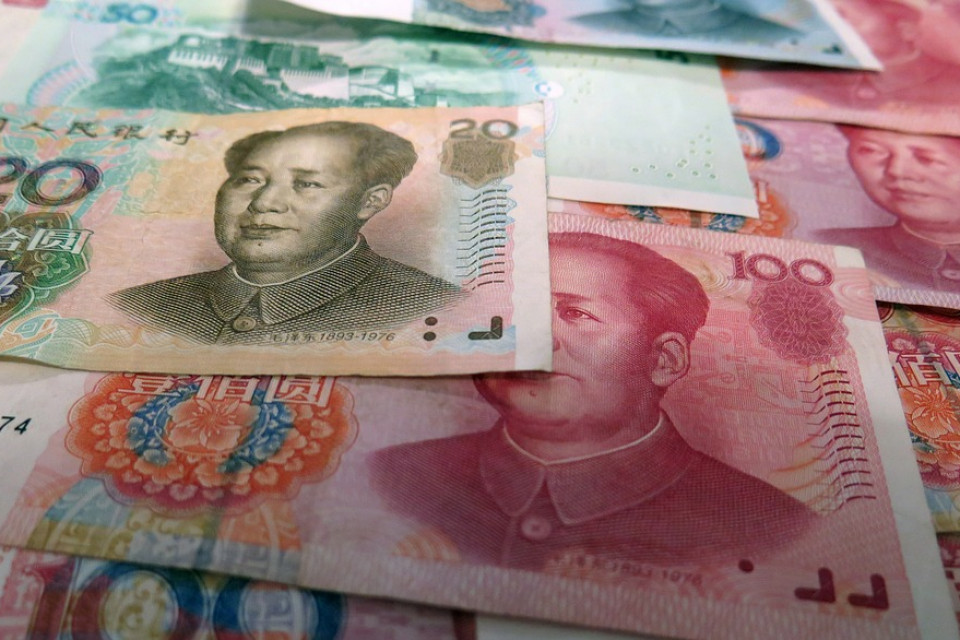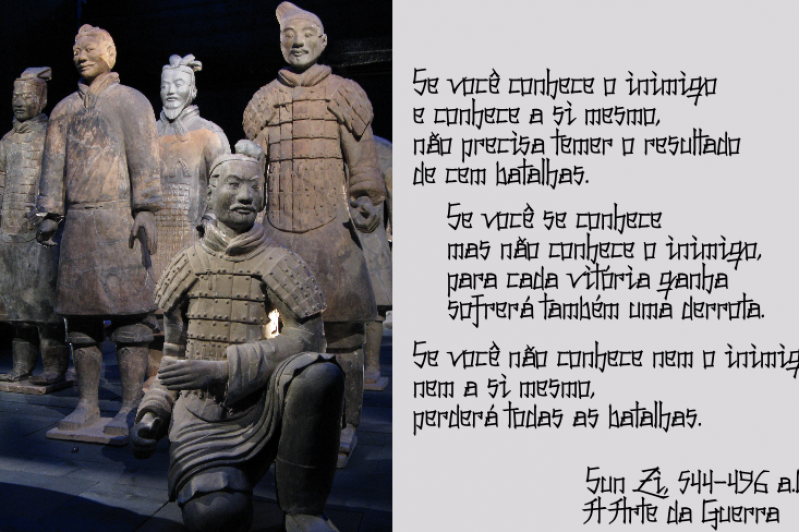On the pretext of defending threats to US national security, President Donald Trump declared the largest trade war in the history of capitalism in January 2018. It began with the unilateral imposition of a 20% general tariffs on the import of LG and Samsung washing machines, and 30% on solar panels, in outright disdain of WTO trade rules. Then it was extended with tariffs of 25% on steel and 10% on aluminium from Canada, Mexico and the European Union as in 1936. With no intervention from any country or from multilateral institutions, the US began a war that involves, as a whole, more than a third of world GDP, 39.1% in 2017. The tariff on solar panels halted the creation of energy alternatives in the United States.
China retaliated against the second round of commercial aggressions, with tariffs of the same measure on US and products. Between April 2018 and June 2019, the conflict has intensified, through six rounds of tariff hikes between the two countries, interrupted by a 90-day truce period between December 2018 and March 2019. The US demands are directed at the reduction of its trade deficit by 60%. They demand that China stop subsidizing technology companies, claim that there is intellectual property theft, and that tariffs on US products are high. They demand that China open up their foreign investment portfolio to US members. In return Washington would provide nothing, except the cessation (not the reversal) of tariff increases.
While the US continues with demands that force China to reorient its production policy with nothing in return, the trade war will not be resolved.
Up to June 2019, tariff offensives compromised 6,213 Chinese products and 6,843 US products with a combined value exceeding $360 thousand million dollars. Paradoxically, thus far the balances of the war have compromised the US more, because its deficit with China increased in 2018. In fact, the increase in tariffs was absorbed by intermediate consumers, mostly companies, and by the final American consumers. (Graph 1)
BBC https://www.bbc.com/news/business-48196495
The question is: Why did the US provoke a trade war with its largest trading member? The US is dragging itself into a downward spiral in the rate of growth of its economy since the 60s. From that time on, its growth rate began to decline decade-by-decade from 4.6% annual average to 2.2% in the 2010's, and only 1.4% had it been measured since the 2007 crisis (see Illustration 2). With globalisation and financial deregulation, US transnational corporations grown global value chains that ended up in the US and that should have reactivated their economy. Instead, they formed an internal dynamic of overconsumption where they import more than they export and consume much more than they produce, with consumer loans that total 200% of GDP and wages that are misaligned with productivity. Beginning in 1980, the end result is a structurally deficitary trade balance This is paid in dollars that were devaluing since 1973.
obela.org with World Bank data
The relocation of US production generated an increasingly less competitive productive apparatus and a more deficitary economy. On the contrary, with the establishment of zones of export processing, China attracted those productive chains of value to its coasts, and promoted its integration into the world market from there. This allowed them to develop an advanced productive apparatus supported with direct foreign investment, import of technology and reverse engineering; analogous to what Japan and South Korea did before. In this way they joined the technological race.
The unprecedented commercial conflict of a national state against a multinational company -Huawei- expresses the crisis faced by the United States in the face of its loss of technological leadership and its desperation to close the production gap. It is not enough to invent - we need to produce. According to the latest report of Worldwide Telecom Equipment Market 2018, Huawei is the most significant telecommunications company in the world, both for the production and output network of intermediate products, but also for the creation of the new generation of wireless telecommunication and its infrastructure. Their closest competitor is ZTE, another Chinese company, with state participation, also investigated and blocked by the US. The problem is that ATT and Verizon cannot bring their 5G networks to market, now almost a year after later after their competitors already did. Both companies were subjected to constant US government aggression for years.
In 2012, the Department of National Security identified an alleged threat to national security interests due to vulnerabilities in the telecommunications production chain.
On December 1st, 2018, the day they agreed to the commercial truce in the G20 in Buenos Aires, Sabrina Meng, the Huawei CEO and daughter of its founder Ren Zhengfei, was arrested in Canada, at the request of the US government, accused of violating trade sanctions against Iran. Huawei has suffered commercial sabotage, with envoys from the State Department to the countries that were going to buy the 5G network in August 2018. It was followed by intellectual property issues and the arrest of its CFO. The latest was the prohibition of Americans trading with Huawei. Beyond the technical elements of connectivity, speed and latency (communication time), the 5G mobile network forms a new technological paradigm, and represents the technical basis of the next generation of productive, consumptive, commercial, military and civic transformations and so on. Its incorporation opens the door to the creation of the Internet of things.
For the USA, the fact that China grown it and launched it on the world market in August 2018 is a clear indication of having lost its technological leadership. The US cannot accept its manifest backwardness in telecommunications because it would be tantamount to accepting loss of technological leadership, and indeed in general. China's retaliation could now be to not export the rare earth minerals necessary to manufacture superconductors, high heat resistant paints, lasers, electric batteries for automobiles, rechargeable batteries of all kinds, lighting, and aluminium alloy to manufacture vehicles.
The salient theme is the international silence in response to the aggressions against the established multilateral order.
It is probable that the USA will continue with aggressions towards its other commercial and productive partners with which it has a deficit: Mexico, Germany (European Union) and Japan, because it cannot compete, neither in prices nor in quality. Mexico is part of its own value chain, so imposing tariffs are nonsense. The attack against Huawei expects that it will bankrupt the company. The prices of its shares have plummeted in Shanghai. All the companies around Huawei will not let this happen. Finally, it seems that this is a process of American economic decline, despite all their inventions.













